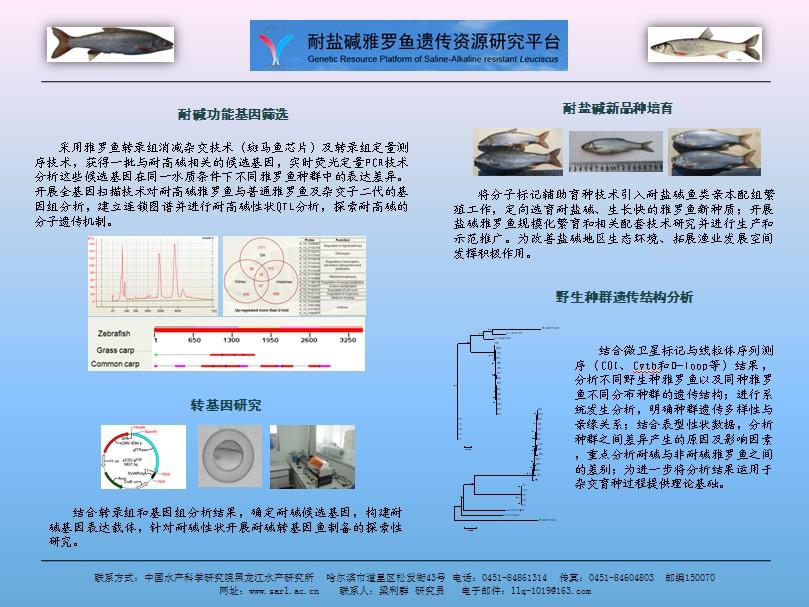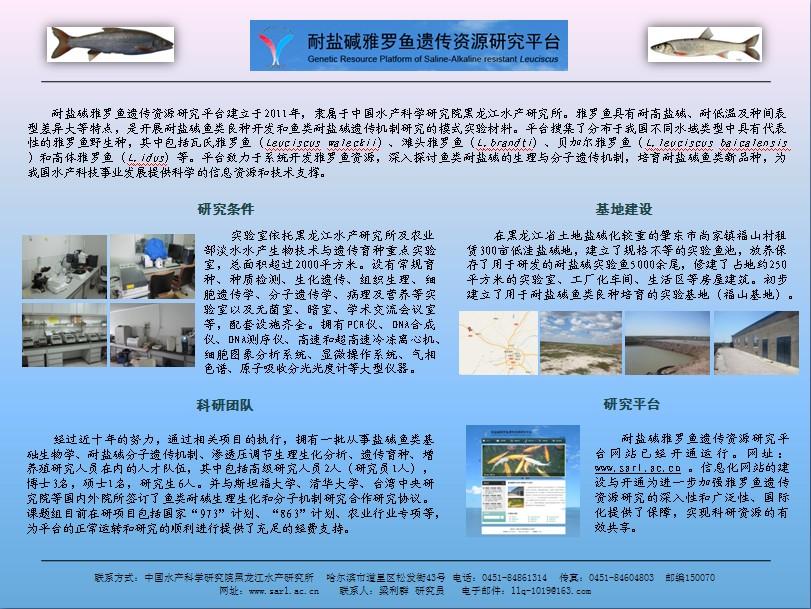耐鹽堿雅羅魚遺傳資源研究平臺致力于系統開發雅羅魚資源,深入探討魚類耐鹽堿的生理與分子遺傳機制,培育耐鹽堿魚類新品種,為我國水產科技事業發展提供科學的信息資源和技術支撐。平臺搜集了分布于我國不同水域類型中具有代表性的雅羅魚野生種,其中包括生長在哈爾濱松花江和內蒙古達里諾爾湖的瓦氏雅羅魚(Leuciscus waleckii)、由日本海溯河至綏芬河產卵的灘頭雅羅魚(L. brandti)、生長在新疆額爾齊斯河的貝加爾雅羅魚(L. leuciscus baicalensis)和高體雅羅魚(L.idus)。雅羅魚具有耐高鹽堿、耐低溫及種間表型差異大等特點,是開展耐鹽堿魚類良種開發和魚類耐鹽堿遺傳機制研究的模式實驗材料。
目前我們利用這些資源已經或即將開展下列研究:
1) DNA分子標記開發:將基因組克隆和轉錄組測序相結合,開發雅羅魚SSR標記、EST標記和SNP標記;
2) 野生種(群)遺傳結構分析:利用分子標記對搜集獲得的不同雅羅魚野生種(群)進行全基因組掃描,分別建立遺傳背景檔案;
3) 遺傳連鎖圖譜構建及QTL分析:根據耐鹽堿特性及表型特征,以不同親本組合制備雜交F2,建立標記與性狀的連鎖關系,開展耐鹽堿、側線鱗、鱗片大小、體型等性狀的QTL分析;
4) 耐高堿分子遺傳機制研究:利用斑馬魚芯片和轉錄組測序技術,分析淡水和堿水瓦式雅羅魚鰓、腎、腸3個組織的基因表達譜差異個組織的基因表達譜差異,獲得一批與耐高堿相關的候選基因。并結合基因組耐鹽堿QTL分析結果,對雅羅魚耐高堿的分子機制進行闡述;
5) 培育耐鹽堿新品種:根據雅羅魚的耐鹽堿特性及表型特征,將分子標記輔助育種與傳統育種技術相結合,確定不同親本配組制備雜交F1,并通過對雜交子代生產性能比較,篩選具有優良性狀的雜交種;利用篩選獲得的耐堿候選基因,通過轉基因技術構建耐鹽堿魚類新品種。
上述研究工作的開展必將推進我國雅羅魚種質資源深度挖掘及保護利用的進程,同時也將對魚類耐鹽堿分子機制的深入研究奠定良好的基礎。培育的耐鹽堿雅羅魚新品種對我國北方水產養殖結構的調整及鹽堿水域水質改良具有十分重要的經濟價值和生態意義。
INTRODUCTION
The platform of genetic resources for saline-alkaline resistant (SAR) Leuciscus will mainly focus on the introduction of the resources of Leuciscus distributed in China, the mechanisms of saline-alkaline resistance clarified in physiological and molecular genetic level, ,and the new varieties of SAR fish species produced through intercross or transgenosis. The representative wild species of Leuciscus distributed in different types of water environment hasve been collected, including the Leuciscus waleckii grown in Songhua River in Harbin and Dalinoer Lake in innerInner Mongolia, the L. brandti migrated from Japan Sea to Suifen River, the L. leuciscus baicalensis and L.idus grown in Erqis River in Xinjiang. The Leuciscus would be a good experimental model for studying the genetic mechanism of saline-alkaline resistance and breeding new SAR fish varieties, due to its excellent performances in high saline-alkaline and low temperature tolerance and remarkable phenotypic differences between species.
Presently, the studies have been or would be carried out as follows:
1). DNA marker preparation The DNA markers of SSR, EST and SNP will be identified based on the genome cloning and transcriptome sequencing.
2). Genetic structure analysis of wild populations Genome-wide scan will be performed for Leuciscus collected from different wild populations by use of the molecular markers.
3). Genetic linkage map and QTL analysis Based on the characteristics of saline-alkaline resistance and phenotypic differences of the wild Leuciscus, the hybrids F2 will be produced to build the genetic linkage constructs and conduct QTL analysis, such as profiles of saline-alkaline resistance, number of lateral line scales, scale size, body shape and so on.
4). Molecular genetic mechanism of saline-alkaline resistance The gene expression profiles of gill, kidney and intestine of L. waleckii from freshwater and alkaline water will be obtained using zebrafish microarray and transcriptome sequencing techniques. A number of candidate genes associated with alkaline resistance will be identified. The mechanism of saline-alkaline resistance would be studied deeply combining the results of QTL fine mapping.
5). Breeding new varieties Based on the characteristics of saline-alkaline resistance and phenotypic features of the wild Leuciscus, the hybrids with superior characteristics will be propagated by combination of the molecular marker-assisted and conventional breeding techniques, and the new varieties of SAR fish species could be prepared by transgenic technology as well.
These researches mentioned above will not only promote the resources utilization and corresponding protection strategies making for Leuciscus, but also lay a good foundation for the studies of the molecular mechanisms of saline-alkaline resistance for fish species. The selected-bred new varieties are of important meanings economically and ecologically in adjusting the aquaculture structure and improving the quality of saline-alkaline water in northern China.
附課題組宣傳資料:

